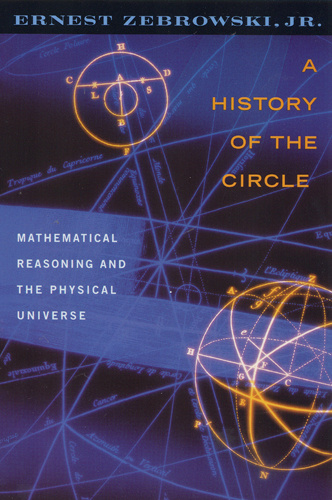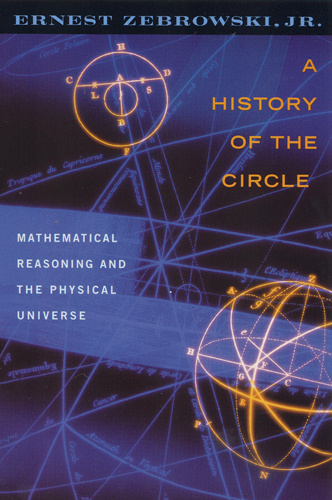A History of the Circle
Mathematical Reasoning and the Physical Universe
The concept of the circle is ubiquitous. It can be described mathematically, represented physically, and employed technologically. The circle is an elegant, abstract form that has been transformed by humans into tangible, practical forms to make our lives easier.
And yet no one has ever discovered a true mathematical circle. Rainbows are fuzzy; car tires are flat on the bottom, and even the most precise roller bearings have measurable irregularities. Ernest Zebrowski, Jr., discusses why investigations of the circle have contributed enormously to our current knowledge of the physical universe. Beginning with the ancient mathematicians and culminating in twentieth-century theories of space and time, the mathematics of the circle has pointed many investigators in fruitful directions in their quests to unravel nature’s secrets. Johannes Kepler, for example, triggered a scientific revolution in 1609 when he challenged the conception of the earth’s circular motion around the sun. Arab and European builders instigated the golden age of mosque and cathedral building when they questioned the Roman structural arches that were limited to geometrical semicircles.
Throughout his book, Zebrowski emphasizes the concepts underlying these mathematicians’ calculations, and how these concepts are linked to real-life examples. Substantiated by easy-to-follow mathematical reasoning and clear illustrations, this accessible book presents a novel and interesting discussion of the circle in technology, culture, history, and science.
I found the book to be fascinating, and the authorÆs presentations and illustrations of the contrasts between mathematical reasoning and scientific reasoning were especially appealing. The book is rich in history, which is carefully integrated into the discussions, and it includes wonderful illustrations and stories.
Zebrowski is a wonderful storyteller, and his choices of topics reveal not only the depth of explanation afforded by the available mathematics but the beauty in the explanations; he succeeds in keeping the explanations accessible to the most general audience.
Throughout his book, Zebrowski emphasizes the concepts underlying these mathematiciansÆ calculations, and how these concepts are linked to real ùlife examples. Substantiated by easy ùto ùfollow mathematical reasoning and clear illustrations, this accessible book presents a novel and interesting discussion of the circle in technology, culture, history, and science.
This is an accessibly written investigation of how past attempts by scientists to discover the perfect circle led to major discoveries of the physical universe.
The book is insightful and clever. It blends the authorÆs background in mathematics and physics to uncover natural occurrences of mathematics in the world around us.
An enjoyably readable treatment of the interaction between mathematical ideals and physical reality. Full of good stories.
From a history of pi to the workings of rollers and gears, from tsunami killer waves to the elusive waves of gravity, from the atom's nucleus to the structure of the universeùhere is a fascinating tour de force of all things circular. After reading ZebrowskiÆs account, you'll get answers to everything youÆve always asked about the circleùand much more!
Rollers, wheels, and bearings
The celestial clock
Mathematics and the physical world
Charting the planet
Surface and space
Celestial orbs
From conics to gravity
Oscillations
Waves
Artificial and natural structures
The real and conjectured universe
Appendix A: Formulas for the areas of common shapes
Appendix B: Formulas for the volumes of common solids
Appendix C: Algebraic equations for the conic sections





